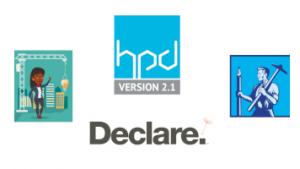HPD Versus The Declare Label: Why Should Building Product Manufacturers Care?
- < 3 Building Product Specification Tactics You Should Retire Immediately
- > LEED Certification and Product Specifications Update
Should a building product manufacturer develop a Health Product Declaration (HPD) or a Declare Label? Both product disclosures are excellent tools but differ in complexity, cost, and potential ROI. There are other excellent sustainability documentation tools available such as Cradle to Cradle, BIFMA, and ANSI resources to meet Materials Ingredients credits. However, our focus today is on HPDs and Declare Labels.
What Is a Health Product Declaration (HPD)?
The HPD Open Standard is a voluntary technical specification for reporting information on product contents and associated health information. The HPD standard was developed by the Health Product Collaborative, with input from architects, designers, specifiers, owners, manufacturers, contractors, and scientists. The HPD provides a standardized way of reporting the material contents of building products, and potential associated human and environmental health hazards.
HPDs can be used for product specification for multiple platforms, including LEED v4 and WELL. Specifically, HPDs can contribute to the WELL Enhanced Material Safety Credit, and the LEED v4 MR credit Building product disclosure and optimization – material ingredients. Being able to contribute to LEED v4 is often the primary reason that manufacturers develop HPDs for their products. Unlike the Declare Label, there is no limit on the amount of proprietary information that can be withheld (i.e. chemical name/CASRN undisclosed) in an HPD that can qualify for the LEED v4 MR credit, as long as all other requirements have been met.
What Does It Cost To Develop an HPD?
Building product manufacturers can self-publish an HPD. Having an HPD published to the HPD Public Repository is one of the requirements for the LEED v4 MR Credit. Manufacturers can purchase a 5 HPD Bundle Pack at the HPDC website for $250. A manufacturer can also become an Affiliate HPDC Member ($500 annually), or a General HPDC Member ($1,500 annually). HPDC members have unlimited use of the HPD Builder, and can publish as many HPDs as needed. HPDs expire and need to be re-published after three years, or within one year of a significant change in a product’s contents.
Product manufacturers can also hire a third-party consultant to help develop their HPDs. Fees for consulting services can range from a few hundred dollars to a few thousand dollars, depending on the scope of the project. In addition, manufacturers can pay to have their HPDs verified by an approved third-party. However, neither of these actions are mandatory to meet the LEED v4 MR credit requirements.
What Are Obstacles Manufacturers May Encounter With HPDs?
There are many LEED v4-compliant HPDs available, but many more HPDs that are not compliant. In fact, a significant number of published HPDs currently do not qualify for the LEED v4 MR credit for various reasons. Manufacturers may make mistakes when developing their HPDs because they are not fully aware of their product’s chemical inventory, not familiar with the HPDC Open Standard, or don’t completely understand the LEED v4 requirements.
Manufacturers may encounter the following issues with HPDs:
- The HPD doesn’t meet the LEED v4 disclosure thresholds. The chemical inventory of the product must be characterized and screened to at least 0.1% (1000 ppm). Many non-compliant HPDs use information solely from Safety Data Sheets, which only disclose chemicals to 10,000 ppm. An HPD is only as good as the data available, and sometimes manufacturers are at the mercy of their suppliers.
- The HPD wasn’t developed in accordance with the HPD Open Standard. The HPD Standard has various requirements for what constitutes a “complete” HPD. The LEED v4 MR credit specifically requires that the HPD be in compliance with the HPD Open Standard.
- Many manufacturers simply don’t have the time, resources, or scientific background to appropriately develop HPDs for their products.
What Is A Declare Label?
A Declare Label answers three questions: Where does the product come from? What is it made of? Where does it go at the end of its life? Declare is owned and operated by The International Living Future Institute. Declare is a voluntary self-disclosure program aiming to transform the building materials industry toward healthier products through ingredient transparency.
The Declare Label has more stringent requirements than the HPD. Product contents must be disclosed by chemical name and CAS number to at least 100 ppm (0.01%), with few exceptions allowed. All building products that have the potential to emit VOCs and are intended for installation within the building envelope must supply a laboratory certificate of compliance with CDPH v1.1-2-10 Standard Method requirements or other conformant product certifications in order to achieve a declaration status of “Red List Free” or “LBC Compliant”.
Like the HPD, the Declare Label can be used to meet LEED v4 MR credit requirements. Declare labels that achieve a declaration status of “Red List Free” or “Declared” fulfill the credit disclosure requirements for LEED v4. Labels that are “LBC Compliant” with a minimum disclosure threshold of 99.9% also meet these requirements. However, this disclosure threshold means that the total amount of proprietary ingredients withheld (i.e. chemical name/CASRN undisclosed) must make up less than 0.1% of the final product.
The Declare Label is an essential part of meeting the requirements of the Living Building Challenge. In addition, Declare is recognized by the US EPA in its Recommendations of Specifications, Standards, and Ecolabels for federal purchasers.

What Does It Cost To Develop A Declare Label?
To create Declare Labels, manufacturers must first have access to Declare Tools, which requires an ILFI Premium Membership ($150 annually). A Declare Label currently costs $1000 for the first product. Two to nine products are discounted at $850 each, and ten or more products cost $750 for each label. The Declare fee corresponds with each label. A single Declare label covers one building product and one final assembly location. If a building product has more than one final assembly location, then the product manufacturer will be charged for each location. Manufacturers wishing to submit a product with five or more manufacturing locations may take advantage of bulk label pricing. Additionally, the more stringent requirements of the Declare Label may add to time and cost needed to properly develop this document.
Labels are valid for a 12-month period and must be renewed at that time at 50% of the original fee (100% of the original fee if changes have been made). Label updates are subject to a redraft fee. Manufacturers that successfully remove proprietary ingredients or Red List chemicals from their product in order to move to a higher Declaration Status will receive label updates free of charge.
What Are Obstacles Manufacturers May Encounter With Declare Labels?
For many product manufacturers, Declare Labels are more difficult to develop than HPDs due to the increased rigor required. The Declare Label has three types of declarations:
- “Declared” products’ ingredients are 100% disclosed to 100 ppm, but contain one or more Red List chemicals that are not covered by an existing Exception. Further, all building products to which CDPH v1.1-2010 is applicable that do not supply a laboratory certificate of compliance or conformant product certification, will be listed as “Declared” regardless of ingredient content.
- “LBC Compliant” products meet the written requirements of the Living Building Challenge, but rely on one or more Exceptions (see appendix B of the Declare Manufacturer Guide) to demonstrate compliance. Product ingredients are, at minimum, 99% disclosed to 100 ppm and/or may contain one or more Red List chemicals that fall under an existing, published LBC Exception.
- “Red List Free” product ingredients are 100% disclosed to 100 ppm and do not contain any Red List Chemicals.
Conclusion
The HPD and Declare Label are both excellent tools for building product manufacturers to show their commitment to transparency and increase specification opportunities. Manufacturers who are just starting their journey down the road of sustainability may opt to pursue HPDs first. HPDs are easier to develop, less expensive, and less stringent than Declare Labels. HPDs provide an effective way to meet LEED v4 requirements and learn about your supply chain.
Declare Labels may be more appropriate for manufacturers who are farther along in their sustainability journey. The Living Building Challenge is an inspiring program, but has more rigorous requirements that most “Mom and Pop” and mid-sized manufacturers may be able to meet.
Manufacturers must also evaluate ROI. While there are tens of thousands of LEED certified buildings on the planet, there are fewer than 20 fully certified Living Building Challenge structures. The direct product specification opportunities for LEED projects versus LBC are considerable. However, many design firms are beginning to incorporate LBC principles and Red List Free declarations into their overall sustainability goals.
Both HPDs and Declare Labels are still in their infancy. It will take many years to work out the kinks with both product declaration programs. There are various technical arguments that advocate for each program, but that is a conversation for another time. Suffice to say, product manufacturers who develop either an HPD or Declare Label should be commended for their efforts.
Has your company developed either HPDs or Declare Labels? What has been your experience working with project teams in delivering them the information they need for either LEED v4 projects or LBC projects?
For more information or to discuss the topic of this blog, please contact Brad Blank





